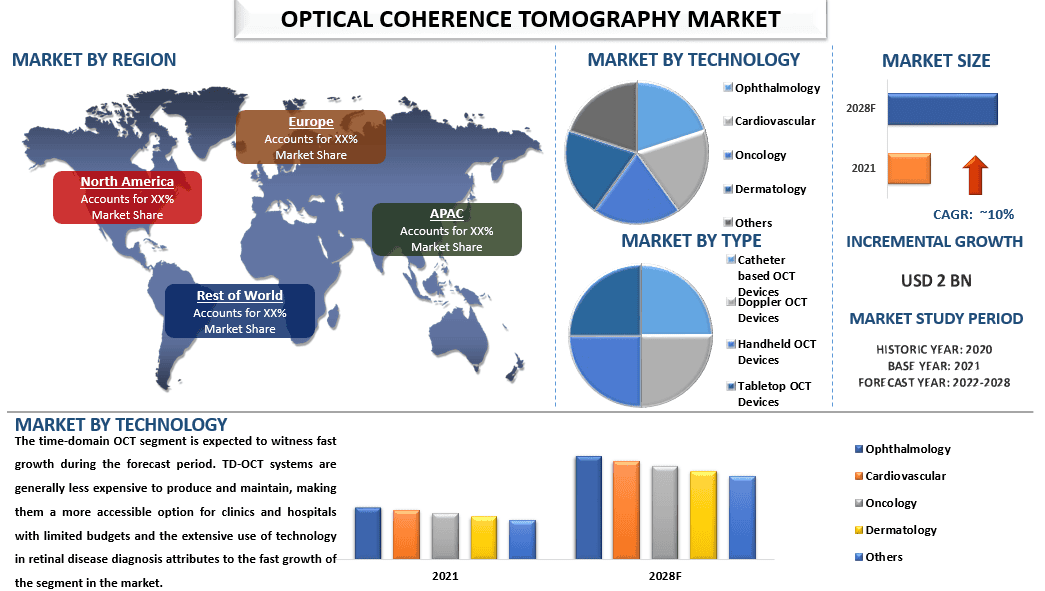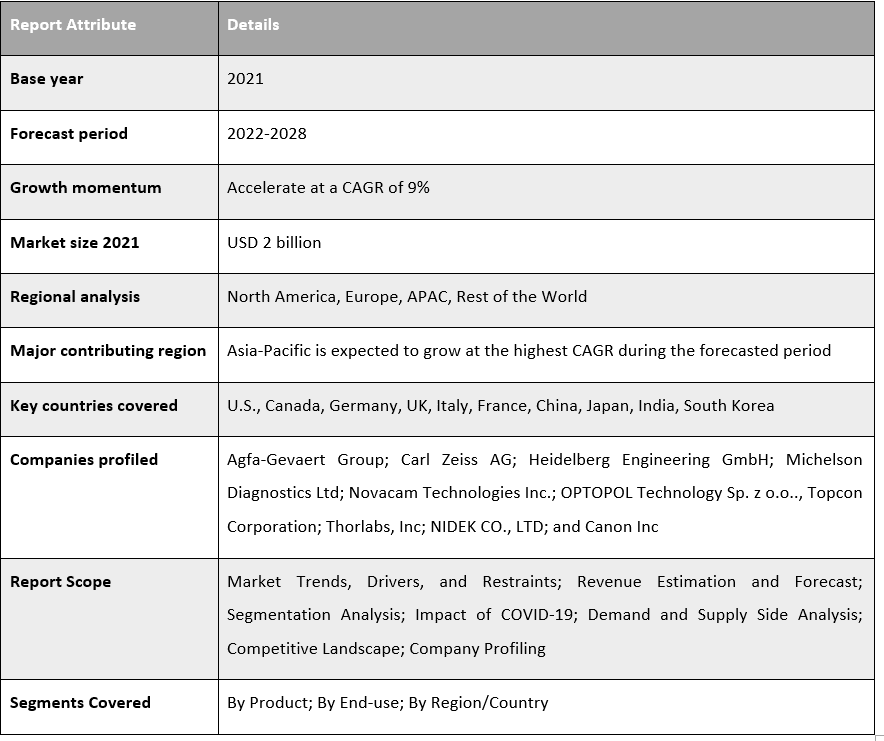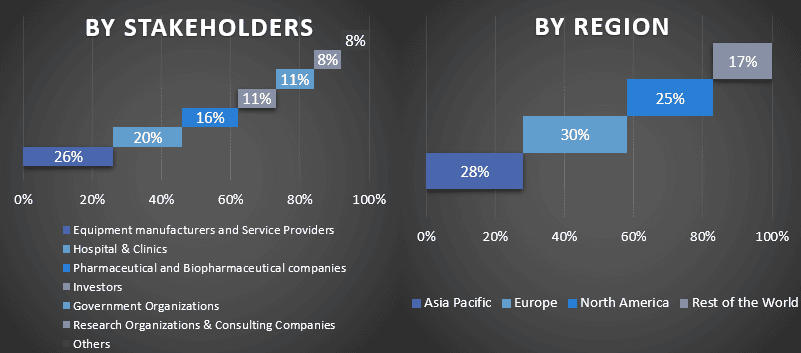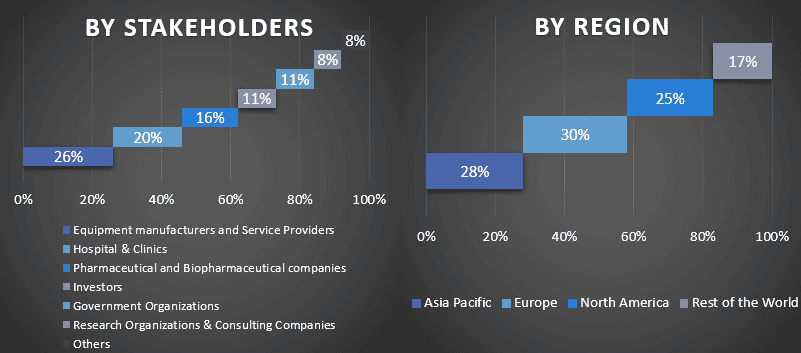Emphasis on Technology (Time-Domain OCT (TDOCT), Frequency Domain OCT (FD-OCT), and Spatial Encoded Frequency Domain OCT); Type (Catheter-Based OCT Devices, Doppler OCT Devices, Handheld OCT Devices, and Tabletop OCT Devices); Application (Ophthalmology, Cardiovascular, Oncology, Dermatology, and Others); and Region/Country

The optical coherence tomography market was valued at USD 2 Bn in 2021 and is expected to grow at a strong CAGR of around 10% during the forecast period (2022-2028). OCT is a non-invasive imaging technique that uses light waves to produce detailed pictures of tissue structures at a few millimeters below the surface. For imaging biological tissues, it is frequently employed in the medical area, particularly in oncology, dermatology, cardiology, and ophthalmology. The demand for optical coherence tomography is increasing due to the rising number of chronic diseases, along with the rising hospitalization are the major factors driving the market growth of optical coherence tomography. For instance, as per the World Health Organization (WHO), Cardiovascular diseases (CVDs) are the leading cause of death globally, taking an estimated 17.9 million lives each year.
Some of the major players operating in the market include Agfa-Gevaert Group; Carl Zeiss AG; Heidelberg Engineering GmbH; Michelson Diagnostics Ltd; Novacam Technologies Inc.; OPTOPOL Technology Sp. z o.o.., Topcon Corporation; Thorlabs, Inc; NIDEK CO., LTD; and Canon Inc Several M&As along with partnerships have been undertaken by these players to facilitate customers with hi-tech and innovative products/technologies.
Insights Presented in the Report
“Amongst technology, the time-domain OCT segment is expected to witness fast growth during the forecast period”
Based on technology, the market is segmented into time-domain OCT (TDOCT), frequency-domain OCT (FD-OCT), and spatial encoded frequency domain OCT. The time-domain OCT segment is expected to witness fast growth during the forecast period. TD-OCT uses a low-coherence light source and a reference mirror to measure the time delay of reflected light waves, allowing for the generation of high-resolution images of tissue structures. TD-OCT market is a lower cost compared to more advanced OCT technologies such as spectral-domain OCT (SD-OCT) and swept-source OCT (SS-OCT). TD-OCT systems are generally less expensive to produce and maintain, making them a more accessible option for clinics and hospitals with limited budgets and the extensive use of technology in retinal disease diagnosis attributes to the fast growth of the segment in the market.
“Amongst Applications, the oncology segment is expected to grow with highest CAGR during the forecast period”
Based on application, the market is segmented into ophthalmology, cardiovascular, oncology, dermatology, and others. Amongst these, the oncology segment is expected to grow with the highest CAGR during the forecast period. The use of optical coherence tomography (OCT) in cancer research and treatment has been a growing area of interest in recent years, as well as OCT has been used in the diagnosis and management of several types of cancer, including skin cancer, breast cancer, and colon cancer and rising cases of cancer attributes to the growth of technology in cancer diagnosis. For example, as per the WHO, Cancer is a leading cause of death worldwide, accounting for nearly 10 million deaths in 2020, or nearly one in six deaths.
“Asia Pacific is expected to grow with highest CAGR optical coherence tomography market during the forecast period”
“Asia Pacific is expected to grow with highest CAGR optical coherence tomography market during the forecast period due to its large population, increasing healthcare expenditure, and growing awareness about the benefits of early disease diagnosis. The region includes countries such as China, Japan, India, South Korea, and Australia. Further, the frequent product launches by the major industrial players attributes to the market growth of optical coherence tomography in the region. For instance, in July 2021, Canon launched Xephilio OCT-S1, a wide-field swept-source Optical Coherence Tomography (OCT) capable of capturing high-resolution images of up to 23 x 20 mm in a single scan for Asia Pacific Region.
Optical Coherence Tomography Market Report Coverage

Reasons to buy this report:
Customization Options:
The global optical coherence tomography market can further be customized as per the requirement or any other market segment. Besides this, UMI understands that you may have your own business needs, hence feel free to connect with us to get a report that completely suits your requirements.
1. Market Introduction
2. Research Methodology Or Assumption
3. Market Synopsis
4. Executive Summary
5. Global Optical Coherence Tomography Market Covid-19 Impact
6. Global Optical Coherence Tomography Market Revenue, 2020-2028f
7. Market Insights By Technology
8. Market Insights By Type
9. Market Insights By Application
10. Market Insights By Region
11. Optical Coherence Tomography Market Dynamics
12. Optical Coherence Tomography Market Opportunities
13. Optical Coherence Tomography Market Trends
14. Demand And Supply-side Analysis
15. Value Chain Analysis
16. Pricing Analysis
17. Strategic Insights
18. Competitive Scenario
19. Company Profiled
20. Disclaimer
Research Methodology for the Optical Coherence Tomography Market Analysis (2022-2028)
Analyzing the historical market, estimating the current market, and forecasting the future market of the global optical coherence tomography market were the three major steps undertaken to create and analyze the adoption of optical coherence tomography in major regions globally. Exhaustive secondary research was conducted to collect the historical market numbers and estimate the current market size. Secondly, to validate these insights, numerous findings and assumptions were taken into consideration. Moreover, exhaustive primary interviews were also conducted, with industry experts across the value chain of the global optical coherence tomography market. Post assumption and validation of market numbers through primary interviews, we employed a top-down/bottom-up approach to forecasting the complete market size. Thereafter, market breakdown and data triangulation methods were adopted to estimate and analyze the market size of segments and sub-segments of the industry pertains to. Detailed methodology is explained below:
Analysis of Historical Market Size
Step 1: In-Depth Study of Secondary Sources:
Detail secondary study was conducted to obtain the historical market size of the optical coherence tomography market through company internal sources such as annual reports & financial statements, performance presentations, press releases, etc., and external sources including journals, news & articles, government publications, competitor publications, sector reports, third-party database, and other credible publications.
Step 2: Market Segmentation:
After obtaining the historical market size of the optical coherence tomography market, we conducted a detailed secondary analysis to gather historical market insights and share for different segments & sub-segments for major regions. Major segments are included in the report as technology, type, and application. Further country-level analyses were conducted to evaluate the overall adoption of testing models in that region.
Step 3: Factor Analysis:
After acquiring the historical market size of different segments and sub-segments, we conducted a detailed factor analysis to estimate the current market size of the optical coherence tomography market. Further, we conducted factor analysis using dependent and independent variables such as product and end-use of the optical coherence tomography market. A thorough analysis was conducted for demand and supply-side scenarios considering top partnerships, mergers and acquisitions, business expansion, and product launches in the Optical Coherence Tomography market sector across the globe.
Current Market Size Estimate & Forecast
Current Market Sizing: Based on actionable insights from the above 3 steps, we arrived at the current market size, key players in the global Optical Coherence Tomography market, and market shares of the segments. All the required percentage shares split, and market breakdowns were determined using the above-mentioned secondary approach and were verified through primary interviews.
Estimation & Forecasting: For market estimation and forecast, weights were assigned to different factors including drivers & trends, restraints, and opportunities available for the stakeholders. After analyzing these factors, relevant forecasting techniques i.e., the top-down/bottom-up approach were applied to arrive at the market forecast for 2028 for different segments and sub-segments across the major markets globally. The research methodology adopted to estimate the market size encompasses:
Market Size and Share Validation
Primary Research: In-depth interviews were conducted with the Key Opinion Leaders (KOLs) including Top Level Executives (CXO/VPs, Sales Head, Marketing Head, Operational Head, Regional Head, Country Head, etc.) across major regions. Primary research findings were then summarized, and statistical analysis was performed to prove the stated hypothesis. Inputs from primary research were consolidated with secondary findings, hence turning information into actionable insights.
Split of Primary Participants in Different Regions

Market Engineering
The data triangulation technique was employed to complete the overall market estimation and to arrive at precise statistical numbers for each segment and sub-segment of the global optical coherence tomography market. data was split into several segments & sub-segments post studying various parameters and trends in the areas of the product, technology, and end-users in the global optical coherence tomography market.
The main objective of the Global Optical Coherence Tomography Market Study
The current & future market trends of the global optical coherence tomography market were pinpointed in the study. Investors can gain strategic insights to base their discretion for investments on the qualitative and quantitative analysis performed in the study. Current and future market trends determined the overall attractiveness of the market at a regional level, providing a platform for the industrial participant to exploit the untapped market to benefit from a first-mover advantage. Other quantitative goals of the studies include:

Customers who bought this item also bought